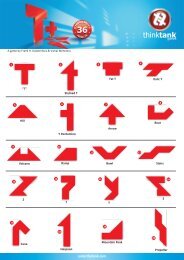Contents: Objective: Game Set Up: How to Play:
Contents: Objective: Game Set Up: How to Play:
Contents: Objective: Game Set Up: How to Play:
Create successful ePaper yourself
Turn your PDF publications into a flip-book with our unique Google optimized e-Paper software.
A game by Frank H. Dyksterhuis & Vishal Mehrotra<br />
<strong>Contents</strong>:<br />
• 16 red tiles • 16 blue tiles • 16 green tiles • 16 yellow tiles • <strong>Game</strong> Board • <strong>Game</strong> Book<br />
<strong>Objective</strong>:<br />
Be the first player <strong>to</strong> successfully place four of your colour tiles in a row (horizontally, vertically or<br />
diagonally) <strong>to</strong> WIN! Simple, right?! Here's the catch: the player who takes his/her turn<br />
immediately before you, sets the limits of what tile(s) you are able <strong>to</strong> play next …<br />
<strong>Game</strong> <strong>Set</strong> <strong>Up</strong>:<br />
Place the game board in the centre.<br />
Each player chooses a colour and<br />
takes all 16 tiles of his/her<br />
chosen colour (fig.1).<br />
You are now ready <strong>to</strong> play!<br />
<strong>How</strong> <strong>to</strong> <strong>Play</strong>:<br />
1.<br />
2.<br />
3.<br />
Each set of 16 tiles contains<br />
four different symbols in four<br />
different symbol-colours.<br />
SQUARE TRIANGLE CIRCLE HEXAGON<br />
Every symbol and symbolcolour<br />
is represented on<br />
the game board four times.<br />
The youngest player opens the game and places his/her first tile anywhere he/she likes on a<br />
corresponding square (such that the symbol and symbol-colour on the tile exactly match the<br />
symbol and symbol-colour on the game board).<br />
<strong>Play</strong> continues in a clockwise direction and the next player must make a move. This next<br />
player can only place a tile that either shows the SAME SYMBOL (in any colour) or any<br />
symbol in the SAME SYMBOL-COLOUR (as the tile just played).<br />
enterthetank.com
Example (fig.2):<br />
The Red <strong>Play</strong>er opens the game by<br />
placing his/her blue square. By<br />
doing this, the Red <strong>Play</strong>er has<br />
immediately limited what move the<br />
next player may make.<br />
It is now the Green <strong>Play</strong>er's turn.<br />
The Green <strong>Play</strong>er, can now place<br />
either a tile that has the same<br />
symbol (in any colour, i.e. the blue,<br />
yellow, green or red square) or a<br />
tile that shows any symbol (in the<br />
same symbol-colour, i.e. the blue<br />
triangle, hexagon or circle).<br />
In the example shown, the Green<br />
<strong>Play</strong>er has chosen <strong>to</strong> play a yellow<br />
square.<br />
Second move by Green <strong>Play</strong>er<br />
Other tile options for Green<br />
<strong>Play</strong>er’s second move<br />
(fig.2)<br />
Opening move<br />
by Red <strong>Play</strong>er<br />
4. On his/her turn, each player must place a tile if at all possible. If in the course of a game, a<br />
player cannot place any tile of the required symbol or symbol-colour, the move passes <strong>to</strong><br />
the next player.<br />
4.<br />
5.<br />
The first player <strong>to</strong> place four in a row<br />
of their own colour tiles wins the<br />
game (fig.3).<br />
(fig.3) Green <strong>Play</strong>er wins by creating<br />
four in a row of own colour tiles.<br />
If a game reaches a stage where<br />
nobody can place any more tiles and<br />
a four in a row has still not been<br />
reached, players must then, on their<br />
turn, swap the position of any of<br />
their own tiles on the board with the<br />
identical tile (identical in symbol and<br />
symbol-colour) of the next player.<br />
(If the sequence of play was Red<br />
<strong>Play</strong>er– Green <strong>Play</strong>er– Yellow <strong>Play</strong>er –<br />
Blue <strong>Play</strong>er, then the Red <strong>Play</strong>er can<br />
only swap a tile with a Green <strong>Play</strong>er's<br />
tile).<br />
Example: If the Red <strong>Play</strong>er wishes <strong>to</strong> move its Blue circle, it can only swap its position with the<br />
Blue circle of the Green <strong>Play</strong>er.<br />
(fig.3)<br />
Be cautious, your swapping may facilitate a win for your opponent(s).<br />
No fresh tiles may be added <strong>to</strong> the game board once tile swapping commences.<br />
enterthetank.com




